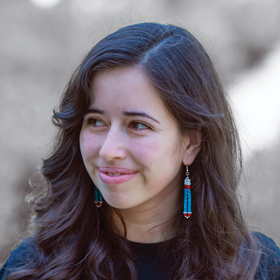2017–18 Outstanding Undergraduate Research Award Winners
Spring
2019
Singularities - Profiles in Physics
2017–18 Outstanding Undergraduate Research Award Winners
Rachel Kaufman, Editor
The SPS Award for Outstanding Undergraduate Research is presented each year to SPS students who demonstrate exceptional research achievements in a physics-related field. Awardees receive a $500 honorarium for themselves, $500 for their SPS chapters, and funding to present their research at a professional physics meeting. SPS is pleased to introduce the most recent winners, Luciano Manfredi Console and Sophia Sánchez-Maes.
Meet Luciano Manfredi Console, Loyola Marymount University
 Right now there are gravitational waves passing through us from black holes that merged way back in the past, in the early universe. We can’t feel them, but we can detect them with a sensitive instrument (like the newly upgraded LIGO). These waves could help us understand how the universe works.
Right now there are gravitational waves passing through us from black holes that merged way back in the past, in the early universe. We can’t feel them, but we can detect them with a sensitive instrument (like the newly upgraded LIGO). These waves could help us understand how the universe works.
As an undergraduate, I fell in love with general relativity. There are some problems with general relativity the way Einstein proposed it. One big problem is dark matter and dark energy, which must be introduced to account for observational data like galaxy rotation curves and accelerating expansion of the universe, which Einstein’s theory alone cannot fully explain. But of course we’ve never seen or detected either, even though general relativity says it should make up 95 percent of the universe. We’ve tried many ways to detect it, so people are starting to think that it doesn’t exist. I started working on a theory called modified gravity (MOG) that doesn’t require dark matter or dark energy to account for what we see in observations.
My research focused on how to test this theory—to find a measure-ment that would be different if MOG was true rather than if general relativity was true. It turns out that merging black holes may hold the key. When two black holes merge, they collide and form a bigger black hole. The collision causes a perturbation, and just like if you hit a bell, it will vibrate. Likewise, just as the bell gets quieter and quieter and eventually stops vibrating, so do black holes. How they do that—what we call the quasinormal mode—is uniquely determined by the theory you use to describe space-time. By finding the quasinormal mode of a black-hole merger, we can compare it to what Einstein’s theory would predict and what we’d expect to see under MOG. Through my work in calculating the quasinormal modes for MOG, we found that they’re very different from general relativity. If we can detect more gravitational waves, we might be able to discover which theory of gravity is more correct.
I’m now pursuing a master’s at Cambridge, going into more heavy math, taking courses in geometry and topology. Research has showed me that I’m passionate about dealing with problems that we don’t know the answers to. I want to stay in academia and give back to society by disseminating knowledge as a professor. I believe that’s something I’ll be good at.
Meet Sophia Sánchez-Maes, Yale University
 My path has varied a lot. It looks like I bounced from tectonics to biofuels to geology to astronomy to physics, but all of these things, to me, feel like a natural progression.
My path has varied a lot. It looks like I bounced from tectonics to biofuels to geology to astronomy to physics, but all of these things, to me, feel like a natural progression.
I grew up in Las Cruces, New Mexico, on the US–Mexico border. Many tech companies funded summer classes to teach Latinas like me how to code. Those classes got me jobs in my high school years—my first job was actually in a physics lab. I was 15, and the job was in Albuquerque, three hours away. I moved in with an aunt for the summer. It was lonely but definitely worth it in the end. That lab taking a chance on a 15-year-old girl meant that at 17 I was working at NASA.
We were looking at exoplanets, and I grew frustrated thinking of these cool worlds that we weren’t thinking of as full, complete worlds. They were just points on a mass-radius plot. That curiosity about what each world was like led me to geology, trying to figure out the fundamental physics of plate tectonics.
Earth is the only planet in the entire universe that we know has plate tectonics. It’s important for the carbon cycle. We know of planets that have volcanoes; they emit gases, but without plate tectonics bringing carbon back into the mantle, the cycle isn’t completed.
There are two hypotheses for how plate tectonics work, basically reducing friction so these giant plates can move. One involves a thermal-cracking process that requires water, and the other involves reducing the size of tiny grains found at plate boundaries. If you want to know which of these processes are necessary for plate tectonics, you follow the energy. The work I did was to prove that plate tectonics requires the thermal-cracking mechanism, which requires water—so now we know that an earth-sized terrestrial exoplanet can’t have tectonics without water as well, and we know that a planet with an active tectonic system must have water. This is important because to a distant observer, Mars, Earth, and Venus all look like they’re in the habitable zone. However, they are not equally habitable. We’ll need to understand how to tell them apart from light-years away.
Now in my senior year, I have switched up my interests yet again. I’m currently conducting research on the quark-gluon plasma in the early universe. It existed in the earliest instants after the big bang and has implications for everything that followed, but we can actually create it experimentally. It’s everything I love—complex systems, fluids, physics, and astronomy.
For more details on the award and recipients, visit the SPS website at www.spsnational.org/awards.
